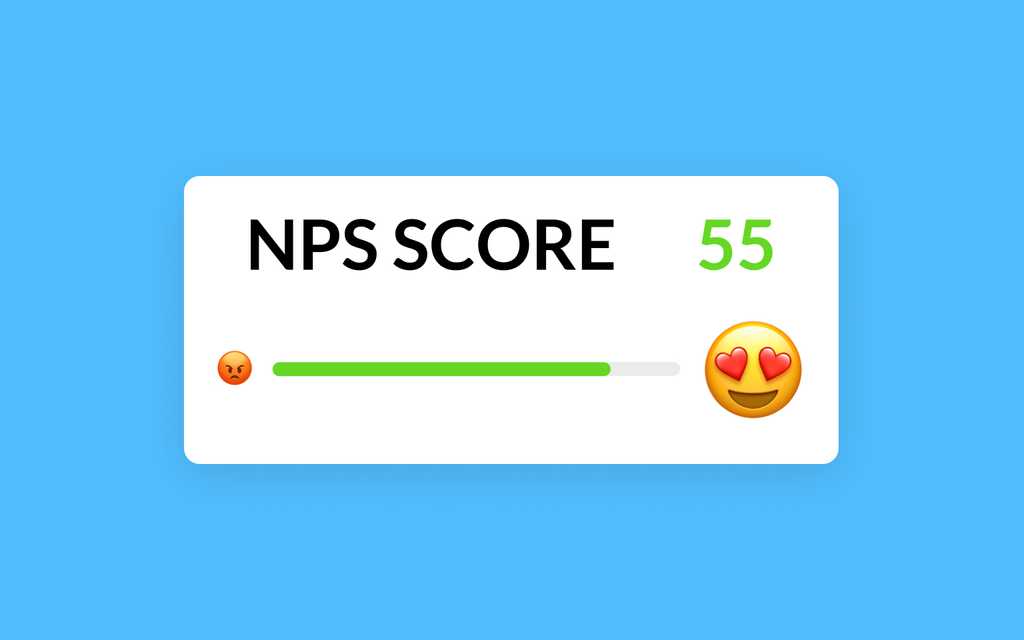Customers are the backbone of every successful business. Therefore, customer experience is important for business growth. When you take care of your customers, it increases your revenue. Net Promoter Score is a way for measuring customer loyalty.
A study revealed that 55% of consumers are willing to pay more for a guaranteed good experience.

The question is, how do you measure customer experience? One way is to measure your Net Promoter Score (NPS).
Measuring NPS is a task every business owner should do regularly.
In this article, you will learn about the following:
- The seven reasons why you need to start measuring NPS
- How to measure NPS
- The tool you need to measure NPS.
But first, let’s start with the definition of NPS.
Let’s get started!
What is the Net Promoter Score?
Net promoter score (NPS) is a tool used to measure customers’ willingness to recommend a product to friends or colleagues.
The NPS measures customer satisfaction and loyalty.
To calculate the NPS, you first need to ask your customers a simple question: “On a scale of 0 to 10, how likely are you to recommend our company or product to a friend or colleague?”
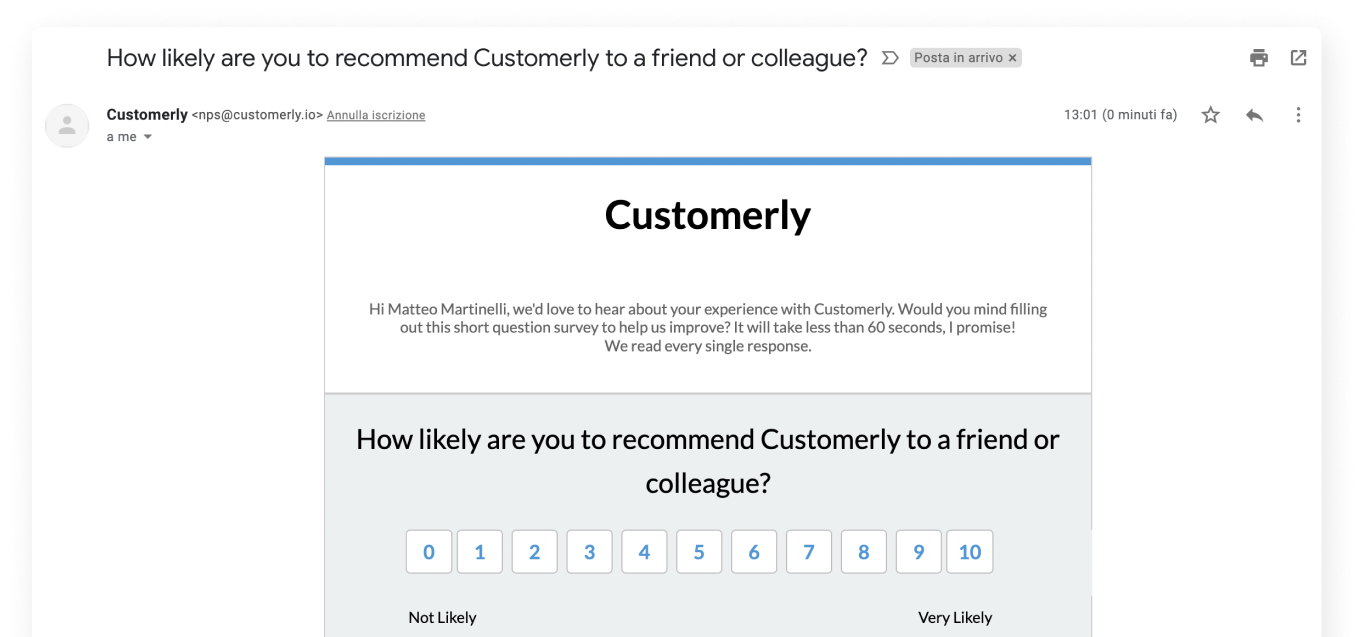
Why should you calculate Net Promoter Score?
Calculating the NPS is important for businesses because it provides a simple, quantitative measure of customer satisfaction and loyalty.
By tracking the NPS over time, businesses can see how their customers feel about them and identify trends and patterns in customer feedback.
This can be useful for identifying areas where the business is doing well and areas where it needs to improve.
Additionally, the NPS is a valuable tool for comparing a business’s performance to its competitors.
By comparing NPS scores, businesses can see how they stack up against their competitors and gain insights into what sets them apart.
This can be useful for identifying improvement opportunities and differentiating the business from its competitors.
Calculating the NPS can be a valuable tool for businesses looking to understand their customers and improve their performance.
It is important because it helps you to measure your customers’ pulse. It shows how well your brand performs and helps you discover your loyal customers. No wonder 45% of the number of respondents surveyed in a report chose NPS as their customer experience of choice.
You need to measure several things to know your business’s health and your customers’ pulse. However, the most important metric you should pay attention to is the Net Promoter Score.
Want to know why?
Check out the seven reasons below:
Measuring NPS will help you identify Product Market Fit and Areas of Product Improvement.
Product market fit is when your product satisfies the market you are in. Josh Porter defined the product market fit as “when people sell for you”.
No matter how new your product is in the market, measuring NPS will help you collect customer feedback. This will show you if your product is fit for the market you are in or not. Secondly, it will help to know which areas of your product need improvement.

Measuring NPS will help you know if your new update is working as it should. In other words, if your customers are giving you bad ratings because of your new updates, you will know and quickly rectify it before it has a negative effect on your business. This information is super useful. It will quickly show you what to do to make your product great for your customers.
Secondly, you need to measure NPS to “secure funding for your startups”.
Measuring NPS can help you secure funding for your startup
You will agree that starting a business and sustaining it needs enormous capital.
According to Studies, over 50 percent of small business fail in the first four years. One reason given for the failure is lack of cash flow.
One way a startup gets capital is through funding. However, getting funding is easier said than done.
But one thing that can help you increase the chances of getting funding for your startup is measuring NPS.
The truth is investors are always on the lookout for the NPS score. It gives them an overview of your startup’s future success.
Like this campaign on wefounder, they reached their funding goal and one of their TOP3 highlights was their Industry Leading NPS Score of 65.
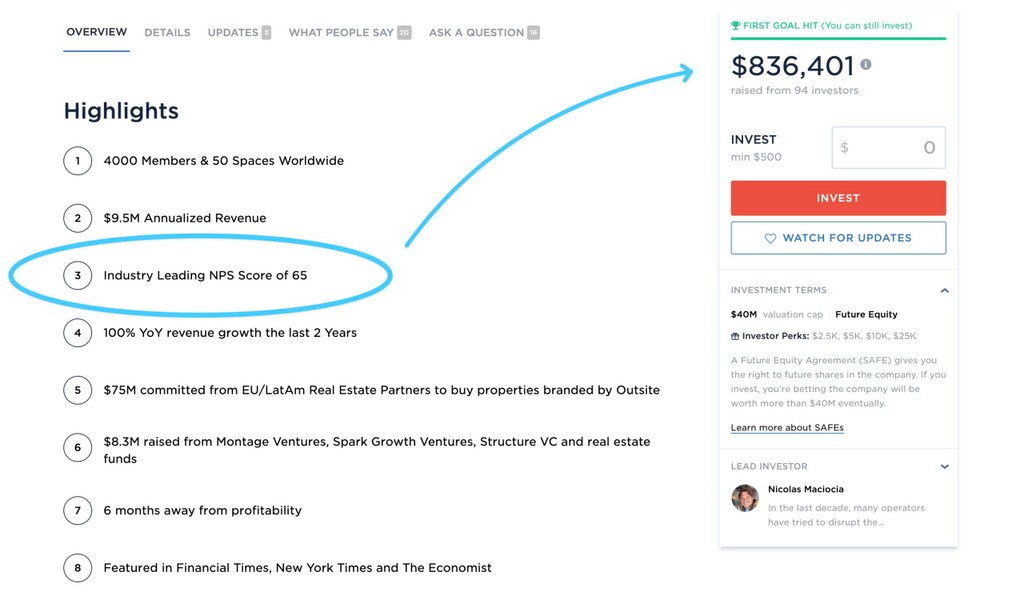
To buttress this, Jason M. Lemkin (An investor) opined that a high NPS score is one of the most significant signs of a good investment.
This makes NPS a valuable tool in evaluating startups.
It does not matter if your startup is new or old or whether you have 10 customers or 10,000 customers; you can still measure your NPS. Even if you don’t make enough money, the good thing is that you have users who will be part of your business.
Thirdly, you need to measure Net Promoter Score to “chart your product roadmap”.
Measuring NPS will help you chart your product roadmap
A product roadmap helps you to choose the direction of your product. It spells out the why and what of your product. Similarly, a product map is very important to the success of your business because it :
- Describes your vision and strategy for the product
- Guides your strategy execution
- Gets your team in alignment
- It helps you to create a better marketing message.
Measuring the NPS is one way to determine if you are on the right path. It will help you know how far you have gone in alignment with your business vision and strategy.

You cannot afford to guess wrong, as it will lead to massive losses. NPS Surveys will help you know whether you are doing the right things.
Measuring NPS helps you to leverage Promoters
As seen above, promoters are satisfied customers who love your product. You can leverage them for more profits, such as:
- Ask them to refer more of their friends and colleagues
- Upsell a new product package to them
- Request for reviews and share their experience with your company.
For example, Agency Analytics leveraged its promoters to enable them to get more positive reviews for their product.
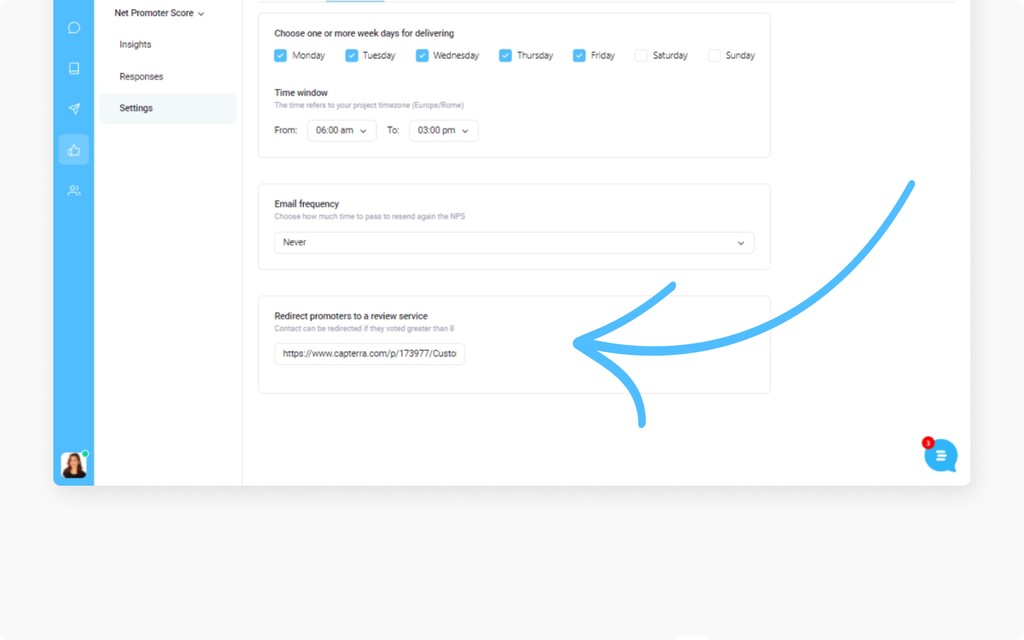
Consequently, this led to a lot of reviews for the company.
Because of that, the reviews are bringing in new customers daily.
It is not a difficult task. Moreover, this is what all businesses can do.
Measuring NPS provides a forecast for revenue and growth.
Measuring NPS gives you an insight into your business revenue and growth. That means if you measure your NPS and it is high, it will lead to increase revenue and growth. This is because a high NPS indicates that your business is getting more income through word of mouth and referrals. That is, the number of your promoters is high. This implies that the percentage of customers that will readily recommend you is increasing.
Frederick Reichheld, in the Harvard Business Reviewed wrote that “the path to sustainable, profitable growth begins with creating more promoters and fewer detractors and making your net-promoter number transparent throughout your organization.”
To sum up, all you need is to constantly measure your NPS to ensure that the number of your promoters is constant and to do all you can to make it stay that way.
Measuring NPS helps you to know your loyal customers
Customer loyalty is one thing that will make you succeed in your business venture. This is because loyal customers spend more.
According to a report, 66% of US customers spend more on brands they are loyal to.
Measuring NPS is one way to discover your happy customers.
They are “the promoters” who recommend your product to friends and colleagues. In short, they are the type of people you need to make your business grow.
Lastly, you need to measure NPS to “know and solve customer issues”.
Measuring NPS will help you know and solve customer issues
Some customers will never complain about your product openly, but quietly, they will stop doing business with you.
Measuring NPS will give you insight into the problems your customers are battling with regarding your product.
This will help you take the necessary steps to solve the problems and stop your customers from churning.
As you get results from the NPS, address each customer’s issue personally. Above all, respond to every complaint from them and provide viable solutions.
You will also truly understand customer needs by reading their sincere feedback.
Certainly, now you are ready to measure your Net Promoter Score. How do you measure it?
Now that you know Net Promoter Score, the next question is: How do you calculate NPS?
NPS Calculation
To calculate the overall NPS score, you take the percentage of promoters’ customers and subtract the percentage of detractors.
Calculating NPS is easier than you think. After you have sent the survey question to your participants, your answers are divided into three parts.
They are:
Promoters NPS Score 9 to 10
Customers who answer 9 or 10 are considered “promoters” and will likely spread positive word-of-mouth about your company. These are customers who are satisfied and love your product. They are a group of customers who readily recommend your product to others around them.
Passives NPS Score 7 to 8
Customers who answer 7 or 8 are considered “passives” and are satisfied with your company but not particularly enthusiastic about it. These customers are satisfied with your product but do not show they love it.
Detractors NPS Score 0 to 6
Customers who answer 0 to 6 are considered “detractors” who are unhappy customers with your company and are likely to spread negative word-of-mouth.

The Net Promoter Score Formula
The formula to calculate your Net Promoter Score is simple, get the total responses to your NPS question, calculate the detractor percentage and subtract it from the Promoter’s percentage.
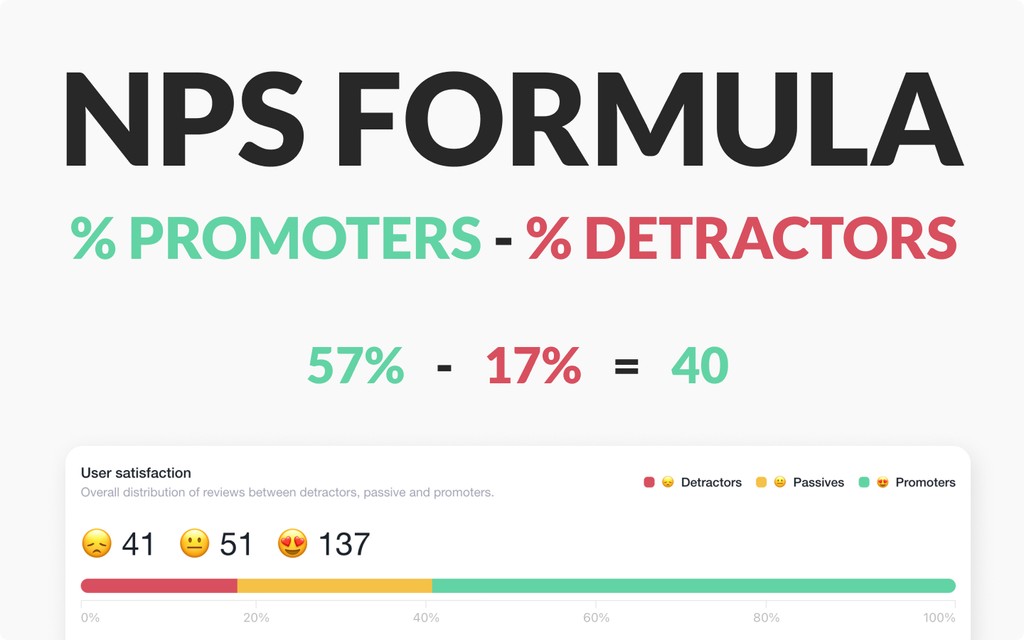
So, for example, if you have 100 customers and 50 are promoters, 40 are passives, and 10 are detractors, your NPS would be 50 (the percentage of promoters) – 10 (the percentage of detractors) = 40.
NPS Score range
The NPS scale range from -100 (if all customers are detractors) to 100 (if all customers are promoters).
Most companies aim for an NPS of at least 50, which indicates that they have more promoters than detractors.
How to measure NPS
To measure NPS, you need to run an NPS survey to collect NPS data daily and be sure your NPS survey results are always up to date.
You can use a free NPS survey template like the one mentioned above or choose an NPS system that automatically calculates your final score or use NPS tools.
Let’s get started.
Go to the Customerly Feedback section, then select Net Promoter Score, and after that, click on “Enable NPS“
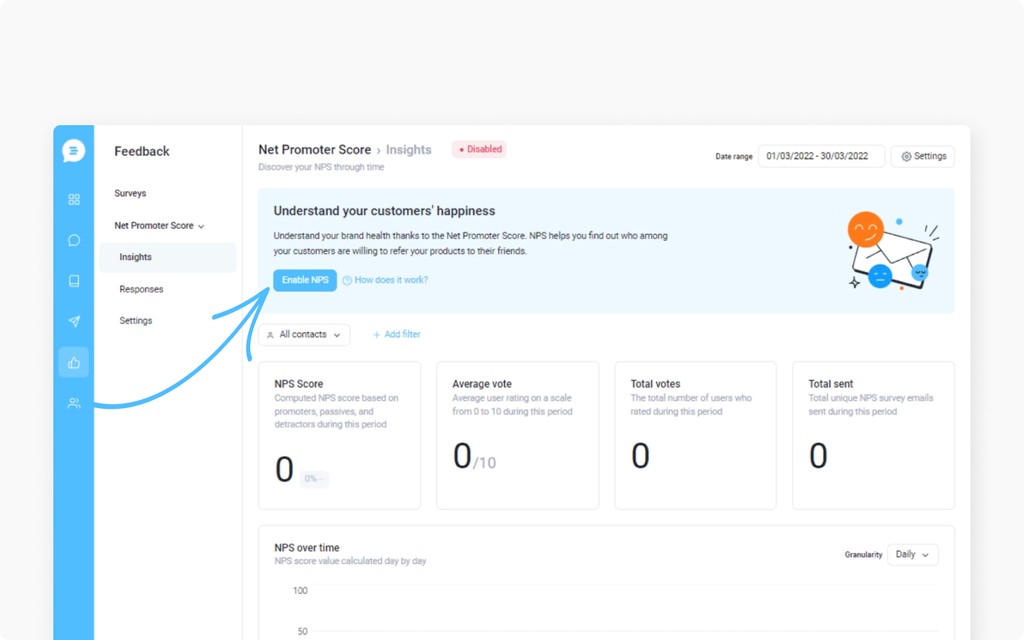
Choose which audience should receive the NPS Score in your NPS settings. In this example, we’ll select all the contacts first seen 30 days ago (this article explains how to define an audience).
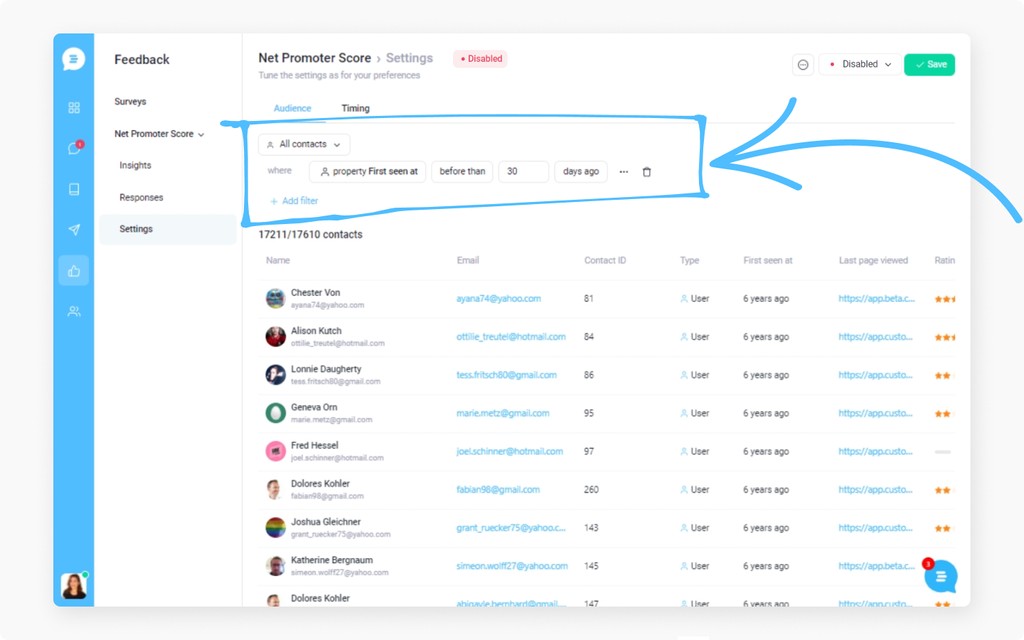
Meanwhile, select the time to deliver the emails to your contact, and then select Enabled and save.
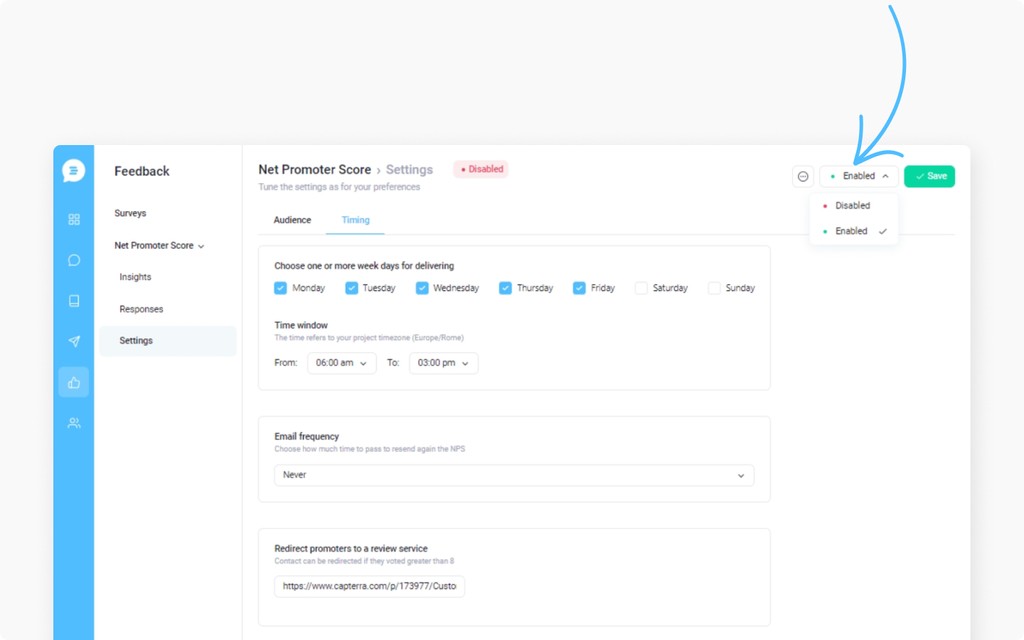
From now on, your contacts will receive the NPS surveys email, and we will calculate your NPS score.
After that, check your NPS report (learn how to interpret the result here).
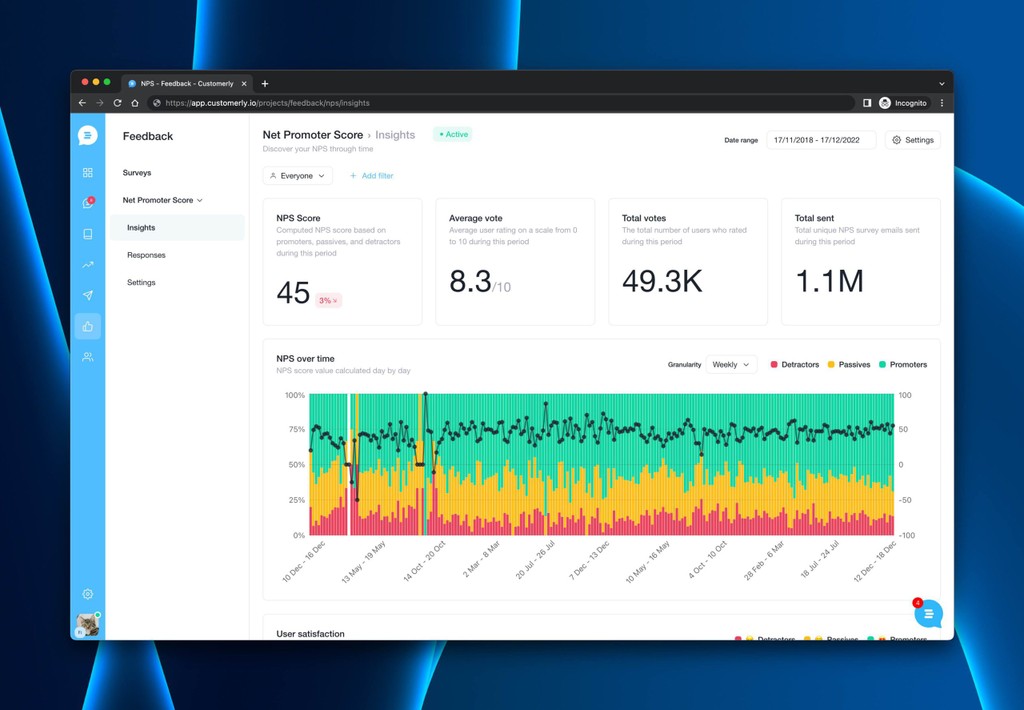
How to improve net promoter score?
Here are some steps businesses can take to improve their Net Promoter Score (NPS):
- Regularly survey your customers to gather feedback on their experiences with your company. This can help you identify areas where your company is doing well and needs improvement.
- Use the feedback you receive from your customers to make changes and improvements to your products, services, and processes. This can help to increase customer satisfaction and loyalty.
- Provide excellent customer service and support. Customers who have a positive experience with your customer service team are more likely to be promoters of your company.
- Respond to customer feedback, both positive and negative. This shows customers that you value their opinions and are willing to make changes based on their feedback.
- Create a customer loyalty program to reward your most happy customers. This can help to increase customer retention and improve your NPS.
- Monitor and track your NPS over time to see how your efforts to improve customer satisfaction impact your score. This can help you identify trends and patterns in customer feedback and make adjustments as needed.
Conclusion
In addition to other metrics you should use to assess the health of your business and that of your customers, you need to measure your NPS.
For instance, most prominent companies and startups have used it to improve their product and, thus, make more money. In the same vein, you should measure your NPS today.
Sign up today for a 14-day free trial to calculate NPS easily without the hassle.
